人教版七年级下册 Unit 4 Don't eat in class. Section A 2d-3c 课件(共17张PPT)
文档属性
| 名称 | 人教版七年级下册 Unit 4 Don't eat in class. Section A 2d-3c 课件(共17张PPT) | 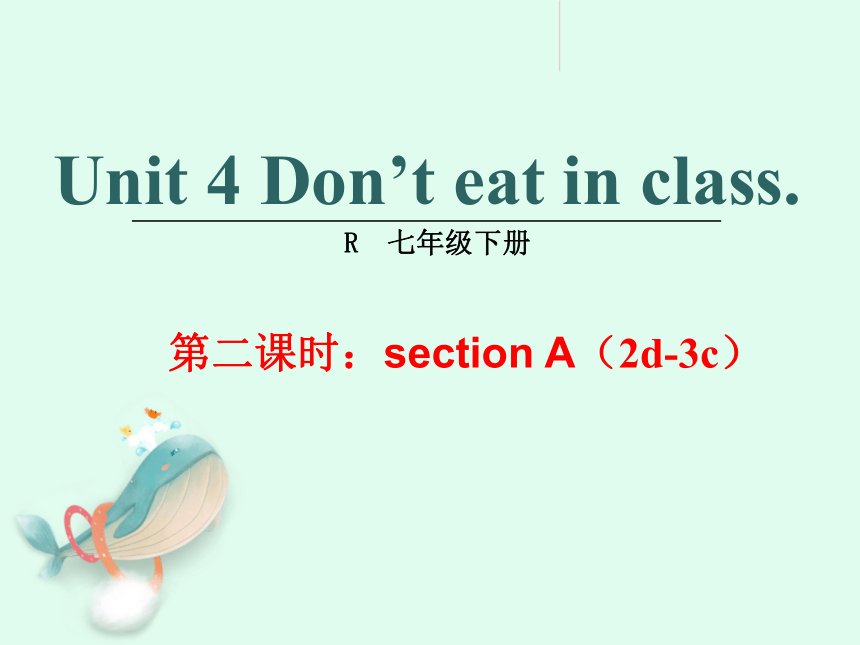 | |
| 格式 | ppt | ||
| 文件大小 | 4.4MB | ||
| 资源类型 | 教案 | ||
| 版本资源 | 人教新目标(Go for it)版 | ||
| 科目 | 英语 | ||
| 更新时间 | 2023-01-10 10:54:06 | ||
图片预览


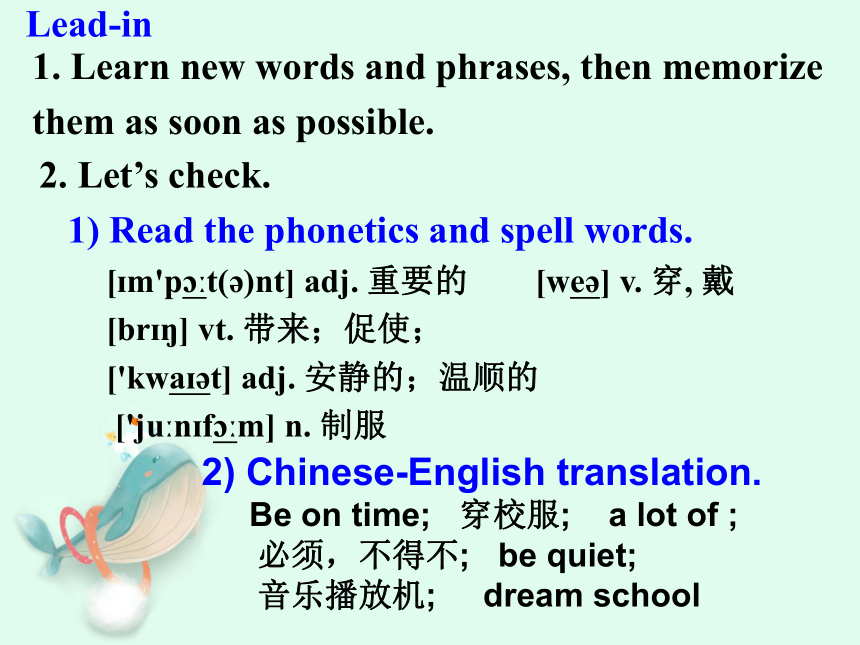

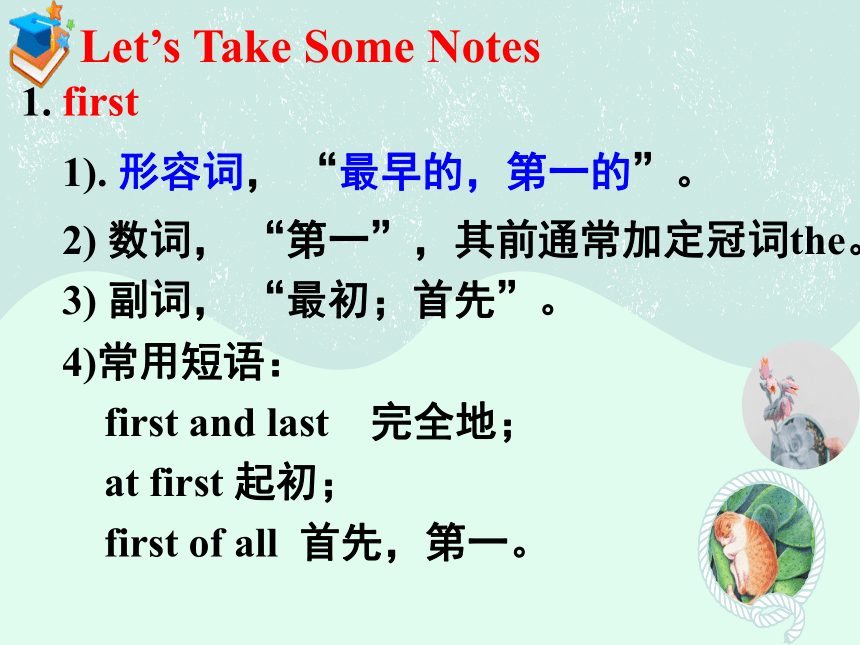
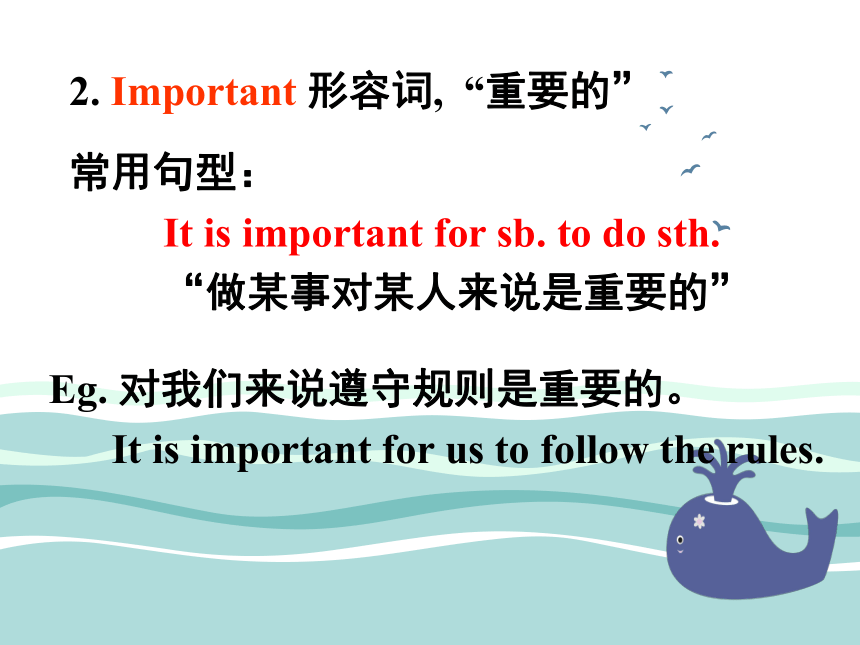
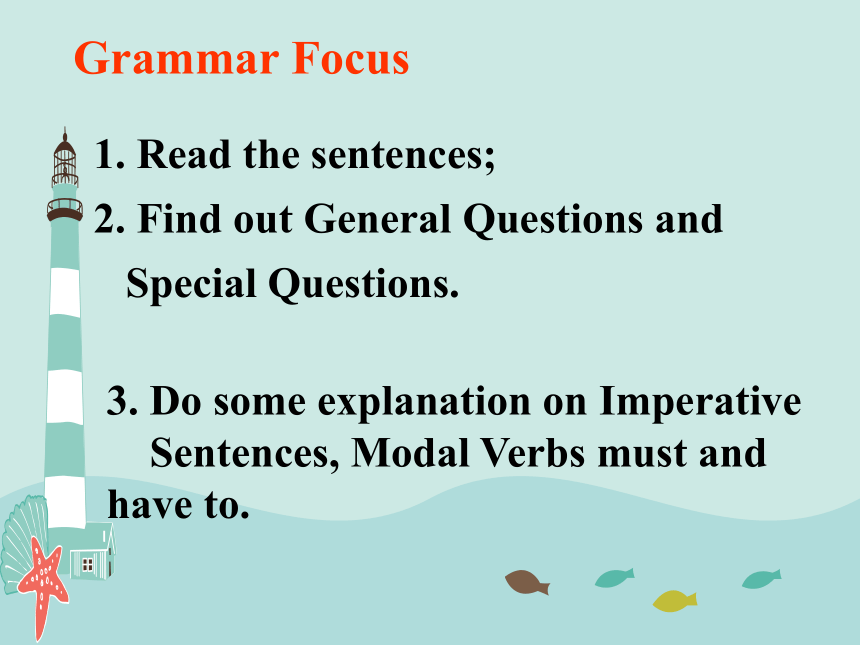
文档简介
(共17张PPT)
Unit 4 Don’t eat in class.
第二课时:section A(2d-3c)
R 七年级下册
1. Review:Tell others about your school rules.
In our school, we can’t listen to music in class…
Warm-up
1. Learn new words and phrases, then memorize them as soon as possible.
2. Let’s check.
1) Read the phonetics and spell words.
[ m'p t( )nt] adj. 重要的 [we ] v. 穿, 戴
[br ] vt. 带来;促使;
['kwa t] adj. 安静的;温顺的
['ju n f m] n. 制服
2) Chinese-English translation.
Be on time; 穿校服; a lot of ;
必须,不得不; be quiet;
音乐播放机; dream school
Lead-in
2d
Role-play the conversation.
Listen and complete the task on your learning paper and check answers.
2. Group work.
Read the conversation and learn about the meaning. Underline the difficulties while you are reading.
3. Role-play the conversation in pairs.
1. first
1). 形容词, “最早的,第一的”。
4)常用短语:
first and last 完全地;
at first 起初;
first of all 首先,第一。
2) 数词, “第一”,其前通常加定冠词the。
3) 副词, “最初;首先”。
Let’s Take Some Notes
2. Important 形容词, “重要的”
常用句型:
It is important for sb. to do sth.
“做某事对某人来说是重要的”
Eg. 对我们来说遵守规则是重要的。
It is important for us to follow the rules.
Grammar Focus
Read the sentences;
Find out General Questions and Special Questions.
3. Do some explanation on Imperative
Sentences, Modal Verbs must and have to.
祈使句(Imperative Sentences)
1. 概念
(1)祈使句是指用来表示请求、命令、叮嘱、建议等的句子。
祈使句没有主语,谓语动词用原形,句末使用感叹号或者句号。
(2)如果祈使句表示客气地请求,一般要
加上please。
Eg. Please read after me.
= Read after me, please.
(请求)
您的标题
2. 祈使句的形式
(1)let开头的祈使句
肯定句: Let’s + v.(原形) + 其他.
否定形式:
1° Don’t + let + 第三人称代词 + v.(原形).
2° Let’s + not + v.(原形).
eg.不要让他们进来。
Don’t let them come in.
eg. 咱们别那样做了。
Let’s not do that again.
(2)非let开头的祈使句:
肯定句
Do 型
: v.原形(+宾语)+其他成份.
eg:Listen to me, please.请听我说。
Be 型:
Be+表语(名词或形容词)+其他成份.
eg:Be quiet, please. 请安静。
否定句
1° Don’t + 行为动词 + 其他.
eg: Don’t play computer games. 不要玩电脑游戏。
2°Don’t + be + 其他.
eg: Don’t be late again. 不要再迟到。
3° No + n./v.-ing.(表示禁止、不准)
eg: No photos. 不许拍照。
No swimming.不许游泳。
情态动词must与have to
1.must的用法
(1)表示有做某一个动作的必要和义务,它的意思是“必须、应该”。
(2)表示有很大把握的判断或者推测,意思是“一定、准是”。
2. have to的用法
have to表示客观需要做的事情,
意思是“必须,不得不”。
(2)have to有人称、数和时态的变化,其第三人称单 数形式为has to。
(3)含有have to, has to的句子变疑问句或否定句需分别借助助动词do, does 。
(1)have to后接动词原形,意为“必须做……;不得不做……”。
否定形式是:
主语+ don’t + have to+动词原形+其他.(一般现在时,当主语是第三人称单数时,用doesn’t have to,—般过去式用 didn’t have to)
2. have to的用法
3a
Write the rules for the school library.
Library Rules
1.________________ 2.__________________
3.__________________ 4.__________________
Don’t talk
Don’t listen to music
Don’t eat or drink
Don’t take photos
2. Eat (he/have to/in the dinning hall)
Q: ________________________________
A: __________________
3. Listen to music (we/can/in the dining hall)
Q: _________________________________
A: _________________
4. Wear a hat (we/can/in the classroom)
Q: ________________________________
A: _________________
Can we listen to music in the dining hall
Yes, he does.
Does he have to eat in the dining hall
No, you can’t.
Can we wear a hat in the classroom
No, you can’t.
3b
See examples and complete the task.
3c
Make up five cool rules for your dream school. Share your rules with the class. Your classmates vote for the Coolest School!
1. We can eat in class.
2. We don’t have to come to school every day.
3. …
At my dream school, we don’t have to come to school every day. We can eat in class. We …
Now, show time!
Thanks for listening!
Unit 4 Don’t eat in class.
第二课时:section A(2d-3c)
R 七年级下册
1. Review:Tell others about your school rules.
In our school, we can’t listen to music in class…
Warm-up
1. Learn new words and phrases, then memorize them as soon as possible.
2. Let’s check.
1) Read the phonetics and spell words.
[ m'p t( )nt] adj. 重要的 [we ] v. 穿, 戴
[br ] vt. 带来;促使;
['kwa t] adj. 安静的;温顺的
['ju n f m] n. 制服
2) Chinese-English translation.
Be on time; 穿校服; a lot of ;
必须,不得不; be quiet;
音乐播放机; dream school
Lead-in
2d
Role-play the conversation.
Listen and complete the task on your learning paper and check answers.
2. Group work.
Read the conversation and learn about the meaning. Underline the difficulties while you are reading.
3. Role-play the conversation in pairs.
1. first
1). 形容词, “最早的,第一的”。
4)常用短语:
first and last 完全地;
at first 起初;
first of all 首先,第一。
2) 数词, “第一”,其前通常加定冠词the。
3) 副词, “最初;首先”。
Let’s Take Some Notes
2. Important 形容词, “重要的”
常用句型:
It is important for sb. to do sth.
“做某事对某人来说是重要的”
Eg. 对我们来说遵守规则是重要的。
It is important for us to follow the rules.
Grammar Focus
Read the sentences;
Find out General Questions and Special Questions.
3. Do some explanation on Imperative
Sentences, Modal Verbs must and have to.
祈使句(Imperative Sentences)
1. 概念
(1)祈使句是指用来表示请求、命令、叮嘱、建议等的句子。
祈使句没有主语,谓语动词用原形,句末使用感叹号或者句号。
(2)如果祈使句表示客气地请求,一般要
加上please。
Eg. Please read after me.
= Read after me, please.
(请求)
您的标题
2. 祈使句的形式
(1)let开头的祈使句
肯定句: Let’s + v.(原形) + 其他.
否定形式:
1° Don’t + let + 第三人称代词 + v.(原形).
2° Let’s + not + v.(原形).
eg.不要让他们进来。
Don’t let them come in.
eg. 咱们别那样做了。
Let’s not do that again.
(2)非let开头的祈使句:
肯定句
Do 型
: v.原形(+宾语)+其他成份.
eg:Listen to me, please.请听我说。
Be 型:
Be+表语(名词或形容词)+其他成份.
eg:Be quiet, please. 请安静。
否定句
1° Don’t + 行为动词 + 其他.
eg: Don’t play computer games. 不要玩电脑游戏。
2°Don’t + be + 其他.
eg: Don’t be late again. 不要再迟到。
3° No + n./v.-ing.(表示禁止、不准)
eg: No photos. 不许拍照。
No swimming.不许游泳。
情态动词must与have to
1.must的用法
(1)表示有做某一个动作的必要和义务,它的意思是“必须、应该”。
(2)表示有很大把握的判断或者推测,意思是“一定、准是”。
2. have to的用法
have to表示客观需要做的事情,
意思是“必须,不得不”。
(2)have to有人称、数和时态的变化,其第三人称单 数形式为has to。
(3)含有have to, has to的句子变疑问句或否定句需分别借助助动词do, does 。
(1)have to后接动词原形,意为“必须做……;不得不做……”。
否定形式是:
主语+ don’t + have to+动词原形+其他.(一般现在时,当主语是第三人称单数时,用doesn’t have to,—般过去式用 didn’t have to)
2. have to的用法
3a
Write the rules for the school library.
Library Rules
1.________________ 2.__________________
3.__________________ 4.__________________
Don’t talk
Don’t listen to music
Don’t eat or drink
Don’t take photos
2. Eat (he/have to/in the dinning hall)
Q: ________________________________
A: __________________
3. Listen to music (we/can/in the dining hall)
Q: _________________________________
A: _________________
4. Wear a hat (we/can/in the classroom)
Q: ________________________________
A: _________________
Can we listen to music in the dining hall
Yes, he does.
Does he have to eat in the dining hall
No, you can’t.
Can we wear a hat in the classroom
No, you can’t.
3b
See examples and complete the task.
3c
Make up five cool rules for your dream school. Share your rules with the class. Your classmates vote for the Coolest School!
1. We can eat in class.
2. We don’t have to come to school every day.
3. …
At my dream school, we don’t have to come to school every day. We can eat in class. We …
Now, show time!
Thanks for listening!
同课章节目录
- Unit 1 Can you play the guitar?
- Section A
- Section B
- Unit 2 What time do you go to school?
- Section A
- Section B
- Unit 3 How do you get to school?
- Section A
- Section B
- Unit 4 Don't eat in class.
- Section A
- Section B
- Unit 5 Why do you like pandas?
- Section A
- Section B
- Unit 6 I'm watching TV.
- Section A
- Section B
- Review of Units 1-6
- Unit 7 It's raining!
- Section A
- Section B
- Unit 8 Is there a post office near here?
- Section A
- Section B
- Unit 9 What does he look like?
- Section A
- Section B
- Unit 10 I'd like some noodles.
- Section A
- Section B
- Unit 11 How was your school trip?
- Section A
- Section B
- Unit 12 What did you do last weekend?
- Section A
- Section B
